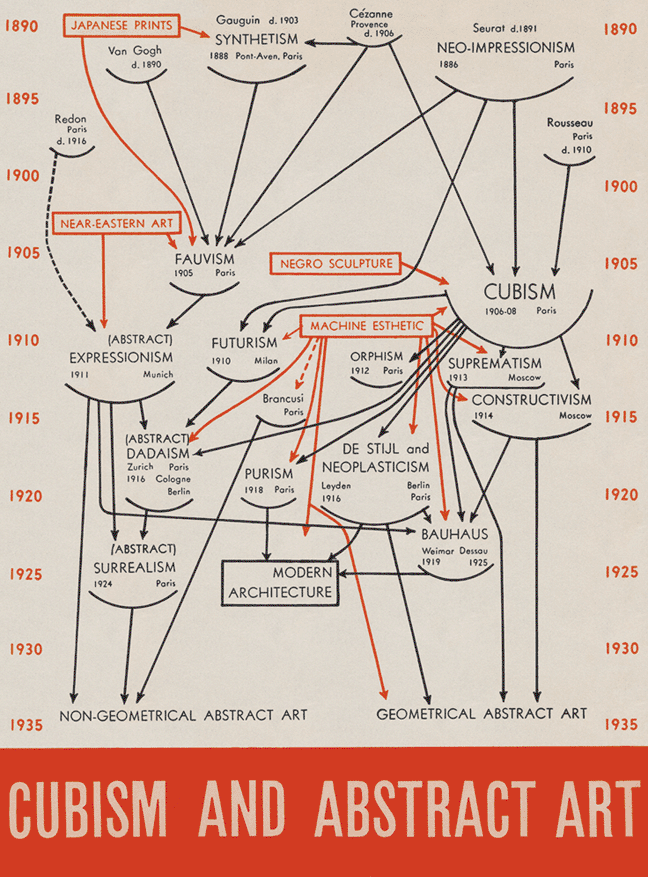Inventing Abstraction is a project that attempts to document some of the origins of modernist abstraction between 1910 and 1925.
The dataset that they’re using for this project imagines 1912 as a radical break from tradition, and forms data around this thesis, naming Kandinsky, Kupka, Picabia, and Delaunay as the people who “presented the first abstract pictures to the public”, which then circulate through figures such as Duchamp, Mondrian, and Malevich. To do so, it uses images of the artists’ works, information about birth and death, birthplace, regions where the artist was active, information about which artists/writers that they encountered, and a couple of ideas that they may have been associated with, or taken inspiration from. (largely, white men)
In terms of how the information is presented, the visual design of the site owes a lot to Alfred Barr’s curatorial/design work from a 1936 exhibition of cubism and abstract art. 
The designers of the Inventing Abstraction page clearly use the same color palette, typeface and general strategy of linking together nodes, but they make the key change of eschewing the teleological tendencies in Barr’s chart.

Rather than flowing from past to present, from “less sophisticated” to more, it presents a rhizomatic network of relations. In doing so, it doesn’t make a key mistake of Barr’s chart, which creates hierarchies and flattens the contributions of people of color into single nodes that are only relevant as originary sources for modern (western) art. (note the total non-specificity of “Japanese Prints”, “Negro Sculpture”, or “Near-Eastern Art”- as if they weren’t hugely diverse bodies with competing schools of thought.) By contrast, Inventing Abstraction does away with the use of arrows, and settles on lines as a less loaded signifier of connections. It also uses specific names instead of attempting to produce a single moment out of an entire ethnically-associated tradition, and has the decency to be specific about its date range.
As far as the interaction itself, it’s a well-designed thing. clicking on a node produces a name, works, birthplace, location, and interests, and maps a direct network of related individuals. The information tends to be somewhat narrow, but probably encompasses most of what a layperson would want to have immediately available.
I very much enjoyed reading this biting piece on “Inventing Abstraction”! I appreciated how you expertly compared Barr’s 1936 exhibition to Inventing Abstraction’s chart – especially noting its modern (and more politically correct) take on contributions of people of color. The incorporation of images in the text allowed me to visualize the differences well and know exactly what to expect as I navigated the site and clicked on the different nodes. Your own personal voice really lit up this description and made it very enjoyable to read!
It was interesting to see that the linkage interface used in the website was inspired by Alfred Barr’s design. Your analysis on the difference between Alfred’s chart and the website’s diagram was also interesting to read- the fact that Barr’s chart was grouping together events while the website was more specific. But maybe Barr couldn’t help it because he didn’t have a large enough space to go into all the details while the website had the capacity since it didn’t have to draw every single connection and could use a program to draw all the details in.
Dear Tang,
As always, it was a pleasure to read your writing. As others have already noted, the depth behind your criticisms is meticulous, well-researched, and provides a wealth of historical context for the information displayed on MoMA’s site. You were keen to notice the lack of arrows in MoMA’s network, which most definitely would create hierarchy between assumed origins and predecessors of modern abstraction.
Lastly, I’d like to thank you for bringing the conversation on node/web design back to socially aware and responsible considerations, such as the representation of different ethnic groups, the underscoring of their individual richness and complexity, and reminding readers of the forces of white-cis-male supremacy, which most definitely plays a role in how we remember and illustrate Abstraction today.
Hi Tang !! I liked your explanation of the “rhizomatic network of relations”– how this tried to deter hierarchies and a flattening of relationships, also the social and political implications of a more traditional timeline. You brought up some pretty complex ideas, but I especially enjoyed how you compared the project to Alfred Bar’s original work, and the possible interventions made by the designers / scholars of “Inventing Abstraction”.